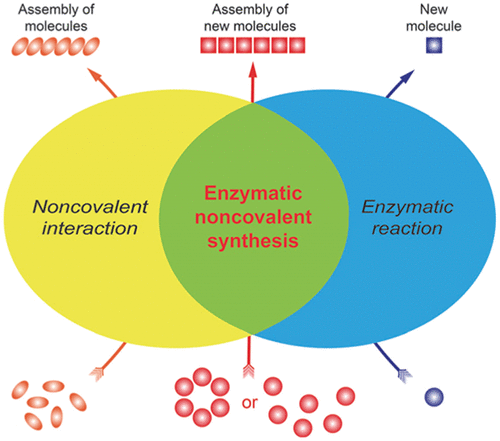当前位置:
X-MOL 学术
›
Chem. Rev.
›
论文详情
Our official English website, www.x-mol.net, welcomes your
feedback! (Note: you will need to create a separate account there.)
Enzymatic Noncovalent Synthesis.
Chemical Reviews ( IF 51.4 ) Pub Date : 2020-08-19 , DOI: 10.1021/acs.chemrev.0c00306 Hongjian He 1 , Weiyi Tan 1 , Jiaqi Guo 1 , Meihui Yi 1 , Adrianna N Shy 1 , Bing Xu 1
Chemical Reviews ( IF 51.4 ) Pub Date : 2020-08-19 , DOI: 10.1021/acs.chemrev.0c00306 Hongjian He 1 , Weiyi Tan 1 , Jiaqi Guo 1 , Meihui Yi 1 , Adrianna N Shy 1 , Bing Xu 1
Affiliation

|
Enzymatic reactions and noncovalent (i.e., supramolecular) interactions are two fundamental nongenetic attributes of life. Enzymatic noncovalent synthesis (ENS) refers to a process where enzymatic reactions control intermolecular noncovalent interactions for spatial organization of higher-order molecular assemblies that exhibit emergent properties and functions. Like enzymatic covalent synthesis (ECS), in which an enzyme catalyzes the formation of covalent bonds to generate individual molecules, ENS is a unifying theme for understanding the functions, morphologies, and locations of molecular ensembles in cellular environments. This review intends to provide a summary of the works of ENS within the past decade and emphasize ENS for functions. After comparing ECS and ENS, we describe a few representative examples where nature uses ENS, as a rule of life, to create the ensembles of biomacromolecules for emergent properties/functions in a myriad of cellular processes. Then, we focus on ENS of man-made (synthetic) molecules in cell-free conditions, classified by the types of enzymes. After that, we introduce the exploration of ENS of man-made molecules in the context of cells by discussing intercellular, peri/intracellular, and subcellular ENS for cell morphogenesis, molecular imaging, cancer therapy, and other applications. Finally, we provide a perspective on the promises of ENS for developing molecular assemblies/processes for functions. This review aims to be an updated introduction for researchers who are interested in exploring noncovalent synthesis for developing molecular science and technologies to address societal needs.
中文翻译:

酶促非共价合成。
酶促反应和非共价(即超分子)相互作用是生命的两个基本非遗传属性。酶促非共价合成(ENS)是指酶促反应控制分子间非共价相互作用以空间组织表现出新特性和功能的高阶分子组装体的过程。与酶促共价合成 (ECS) 一样,酶催化共价键的形成以生成单个分子,ENS 是理解细胞环境中分子整体的功能、形态和位置的统一主题。本篇综述旨在对 ENS 近十年来的工作进行总结,并强调 ENS 的功能。在比较 ECS 和 ENS 后,我们描述了一些代表性的例子,其中大自然使用 ENS 作为生命规则,来创建生物大分子的集合,以实现无数细胞过程中的新兴特性/功能。然后,我们重点关注无细胞条件下人造(合成)分子的 ENS,并按酶类型进行分类。之后,我们通过讨论细胞间、细胞周围/细胞内和亚细胞 ENS 在细胞形态发生、分子成像、癌症治疗和其他应用中的应用,介绍了在细胞背景下对人造分子 ENS 的探索。最后,我们对 ENS 在开发功能分子组装/过程方面的前景进行了展望。本综述旨在为有兴趣探索非共价合成以开发分子科学和技术以满足社会需求的研究人员提供最新的介绍。
更新日期:2020-09-23
中文翻译:

酶促非共价合成。
酶促反应和非共价(即超分子)相互作用是生命的两个基本非遗传属性。酶促非共价合成(ENS)是指酶促反应控制分子间非共价相互作用以空间组织表现出新特性和功能的高阶分子组装体的过程。与酶促共价合成 (ECS) 一样,酶催化共价键的形成以生成单个分子,ENS 是理解细胞环境中分子整体的功能、形态和位置的统一主题。本篇综述旨在对 ENS 近十年来的工作进行总结,并强调 ENS 的功能。在比较 ECS 和 ENS 后,我们描述了一些代表性的例子,其中大自然使用 ENS 作为生命规则,来创建生物大分子的集合,以实现无数细胞过程中的新兴特性/功能。然后,我们重点关注无细胞条件下人造(合成)分子的 ENS,并按酶类型进行分类。之后,我们通过讨论细胞间、细胞周围/细胞内和亚细胞 ENS 在细胞形态发生、分子成像、癌症治疗和其他应用中的应用,介绍了在细胞背景下对人造分子 ENS 的探索。最后,我们对 ENS 在开发功能分子组装/过程方面的前景进行了展望。本综述旨在为有兴趣探索非共价合成以开发分子科学和技术以满足社会需求的研究人员提供最新的介绍。











































 京公网安备 11010802027423号
京公网安备 11010802027423号